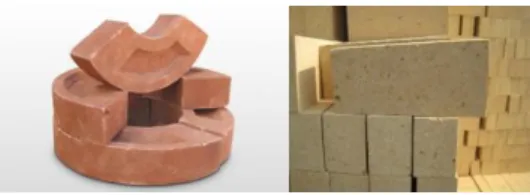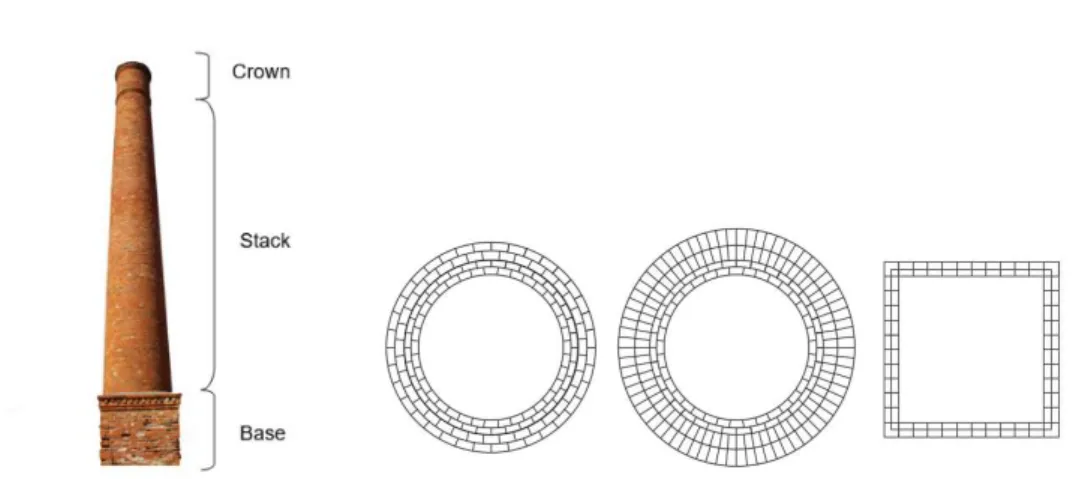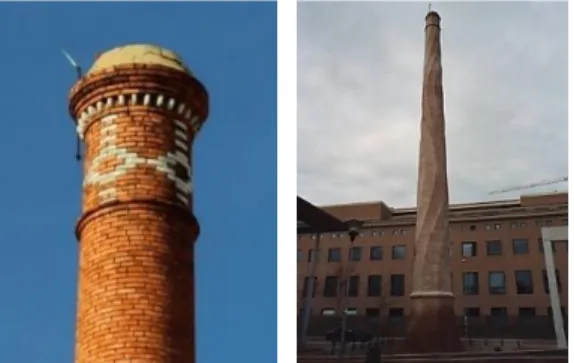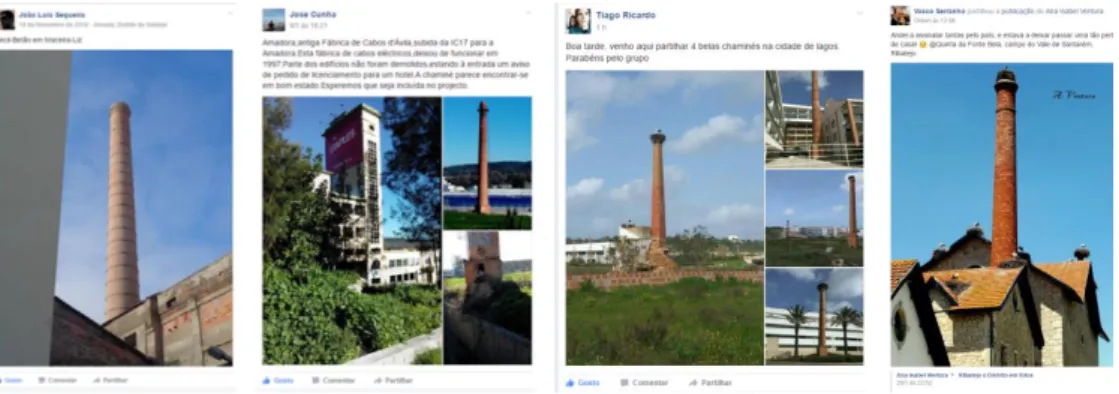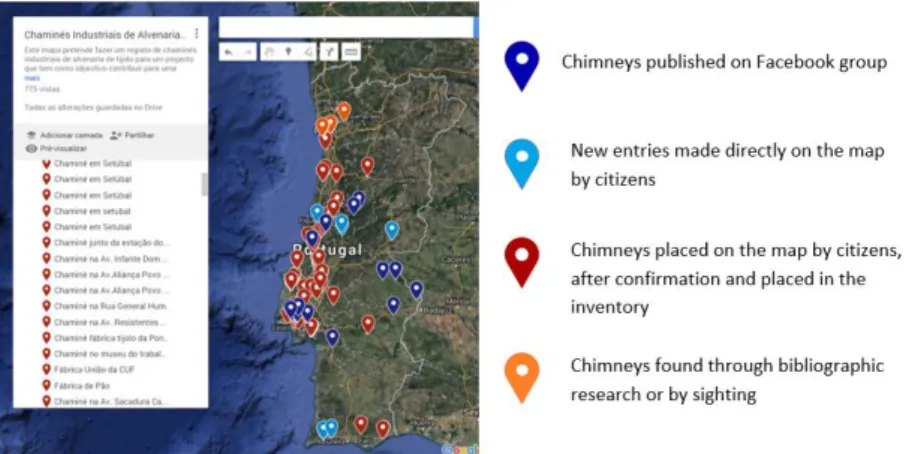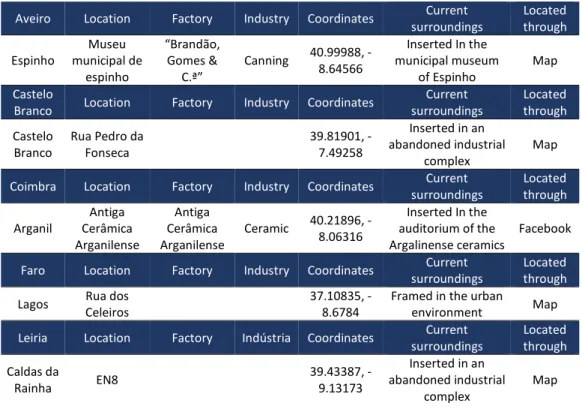INDUSTRIAL MASONRY CHIMNEYS. A FORGOTTEN
SYMBOL OR A CHERISHED HERITAGE?
Nicole Cardoso1, Marluci Menezes2, Paulina Faria3
1 Departamento de Engenharia Civil, Universidade NOVA de Lisboa – UNL, Portugal, nc.cardoso@campus.fct.unl.pt
2 Laboratório Nacional de Engenharia Civil – LNEC, Portugal, marluci@lnec.pt, Portugal 3 CERIS e Departamento de Engenharia Civil, Universidade NOVA de Lisboa – UNL, Portugal, paulina.faria@fct.unl.pt
ABSTRACT
The conservation of industrial heritage is a relatively recent issue, but it has gained importance not only by the scientific community but also by the citizens, some of them gathered in groups that demand their safeguard. This growing interest raises questions such as; "What and why to preserve?", "What values should be safeguarded?". These questions may have different answers depending on the social groups of interest. One essential factor to answer these questions is to understand how citizens can be involved in built heritage conservation. This communication intends to discuss these questions by presenting several initiatives that integrate Citizen Science in a contribution to the conservation of old industrial ceramic masonry chimneys. This contribution is part of a master's thesis in civil engineering that also intends to make a physical characterization of some representative old industrial chimneys and an inventory of those chimneys in Portugal, counting with contributions of interested people.
Keywords: Industrial Heritage; Tangible; Intangible; Value; Citizen Science.
1 INTRODUCTION
The interest and fascination about the industrial heritage or even the recognition of its meaning is something that only began to emerge after the Second World War with the destruction and disappearance of many factories in the 1950’s. But over the years it has been gaining expression and importance not only to Associations dedicated to heritage but also to the community at large.
It is essential to understand what values underlie the traces left by the industry, what should be preserved and why and how to perform in different circumstances. To answer these questions, it is fundamental to understand how the heritage is integrated into the life of the populations and how society can intervene in its conservation, since they have a fundamental role on this matter, being the most interested in the preservation, protection and valorisation of their built patrimony.
The increasing urbanization, the deactivation and evolution of industry led many old factories to disappear and, in many cases, only their chimneys remained in the landscape as an imprint of the old industry. In these cases, frequently the old factories are razed but the chimneys are preserved, integrating themselves into the urban landscape (Figure 1 - centre). In other instances, the reuse of the buildings allows the conservation of the industrial facilities in its whole, like the old Arganil ceramics factory, which after 20 years of inactivity has been re-qualified and is now a multipurpose built facility for cultural, scientific, social and other initiatives (Figure 1 – right). It is lamentable that many factories have been destroyed rather than preserved through a reuse of their spaces. All the factories that were re-qualified gave way to magnificent locations.
Figure 1: An abandoned chimney in Cacilhas (left). A preserved chimney in the middle of a square in Montijo (center) and the rehabilitated old Arganil ceramics factory (right)
(photo from CIM/RC)
From an engineering perspective and the employment of a collaborative methodology, that are by definition a technique that conjoin various groups or individuals to share their knowledge and ideas on a particular subject matter and allows a broader enlightening approach (SCEI, 2010). The present study is integrated in a broader project which aims to contribute to the legitimate conservation of industrial masonry chimneys. For this purpose, it is intended to characterize the chimneys at a material and immaterial level.
With regard to the immaterial part, and based on a science and citizenship initiative, were created online platforms to muster and disclose contributions, moreover, a collaborative map1 was carried out to incorporate locations, photos and information of
industrial ceramic brick chimneys in the Portuguese territory. For a proper analysis of this patrimony, was produced a technical sheet for inventory that allows to identify not only the location of the chimney but also some advantageous information.
2 BRIEF CHARACTERIZATION OF INDUSTRIAL MASONRY
CHIMNEYS
2.1 MATERIALS
There are several typologies of industrial chimneys. Regarding the materials, they can be of different categories, like stone or brick masonry, concrete or steel. The present study focuses on brick masonry chimneys. The bricks used in these constructions may be red clay bricks (Figure 2 – left) or, for resistance to very high temperatures an inner layer was made in refractory brick (Figure 2 – right). Regarding their shape, the bricks can be straight, curved (Figure 3 – left) or with wedge shape (Figure 3 - right). These chimneys initially were constructed with lime mortar. When Portland cement appeared (in Portugal, during the first half of the 20th century) the joints of the chimneys began to be constructed with this material.
Figure 2: Red clay brick (left) and refractory brick (right)
Figure 3: Curve shape bricks (left) and bricks with wedged shape (right)
2.2 SHAPE AND CROSS SECTION
The constitution of the chimneys is divided into three parts. The base is the lower part of the chimney, where normally the entrance is located. The base also ensures the transmission of the loads to the foundations. The stack is the most important element, and it is responsible for conducting the smoke upwards. The height of the stack is variable and this element is normally conical in shape. Finally, the crown is the top of the chimney. The function of this element in purely ornamental. Many builders used the crown as their mark of distinction (Pallarés et al, 2011). Figure 4 (left) illustrates the constitution of the chimneys.
The height of the chimneys varied between 20m and 50m, but there were some specimens much higher, reaching 100m. The height of the chimney depended on the prevailing wind, type of industry, topography, and the proximity of nearby towns, among other aspects (Pallarés et al, 2011).
produced and applied.
Figure 4: Constitution of the chimneys (left) and three examples of the cross section of the chimneys (right)
2.3 PHYSYCAL AND MECHANICAL CHARACTERIZATION
With the collaborative map, some chimneys will be selected to further characterization by visual inspection and non-destructive in situ tests. Whenever possible – often the chimneys are partially destructed and there are samples of masonry elements on the pavement – brick samples of the old chimneys will be collected and brought to the laboratory. This allows another goal of the present project: to make a physical characterization of the material of the chimneys. Thus, for the time being, bricks and masonry samples were already collected for future laboratory tests, from five different chimneys: one in Amadora, another in Arrentela, and three from Setúbal. The laboratory tests that will be performed are: dimensions survey, colour analysis, bulk density, thermal conductivity, water absorption by capillarity and water absorption by Karsten tubes, abrasion tests, surface strength determination, modulus of elasticity, flexural and compressive strength.
3 THE VALUES OF INDUSTRIAL HERITAGE AND OLD CHIMNEYS
It was not until recently that the concern for the protection of industrial heritage, and the awareness that tangible and intangible heritage have a great value for the community, either in historical, technological, social, cultural, architectural or scientific terms (TICCIH, 2003) began to emerge.
The issue of heritage conservation is deeply linked to the meaning of values, since what has no value has no interest to be preserved. It is then necessary to understand what values are attributed to heritage. This assessment will be a decisive factor in how to perform towards heritage (Mason, 2002) and for conservation actions to be as appropriate and relevant as possible.
memories to the population. Therefore, it has an important historical, social and cultural value, being a testimony of the evolution of the industry, that allows knowing aspects of the past, to enrich the present and to build the future. The concept of industrial heritage includes constructions and places where activities related to industry have taken place and have profound historical consequences (TICCIH, 2003), and were often a symbol of the technological and economic development of many societies.
The industrial brick masonry chimneys are a landmark of the old industry, and can be found a bit throughout the Portuguese territory, also representing a valuable example of architecture and construction techniques of the past that must be preserved (Lopes et al., 2009).
Some very pertinent questions that can be asked are: why so many factories are destroyed and not reused, and only the chimneys are maintained? After all, shouldn’t industrial heritage be preserved as a whole? This does not happen due to increasing urbanization and technological and social evolution. This issue shows the conflict between the growing urbanization of spaces and society evolution with the will to preserve the industrial heritage. With the presence of the chimney it is possible to remember and to revive what once, in that location, was a working environment and led to great evolution, which leaves a milestone in the hearts of the community, even if the whole factory does not exist. The chimneys are also a landmark in the landscape, giving character and identity to spaces and creating a connection between the people and their land. This shows the importance of the conjugation of tangible and intangible aspects of this heritage.
The artistic value attributed to the chimneys is unquestionable. In addition to being a slender and imposing element, most of the chimneys, when constructed, were embellished in the crown, with an “author's mark” as it is shown in Figure 5 (left). Sometimes, the stack can also be a different and very interesting element - Figure 5 (right) show an example.
Figure 5: Examples of a decorated crown (left) and stack (right) (right photo from Pallarés et al, 2011)
4 CITIZEN SCIENCE INITIATIVES
the industrial heritage to partake in these initiatives. With this intent, the concept of Citizen Science emerges.
The concept of Citizen Science is multidisciplinary and can be applied to several subjects. This concept consists of a research approach that includes citizens in scientific projects (European Citizen Science Association, 2015).
“Citizen science is the involvement of the public in scientific research – whether community-driven research or global investigations. The Citizen Science Association unites expertise from educators, scientists, data managers, and others to power citizen science” (Citizen Science.Org).
Citizens participate actively, consciously and voluntarily by providing useful contributions to the process of producing scientific results. The main goal of these initiatives is to benefit both citizens – mainly through the increase of a scientific conscience and, in this case, patrimonial conscience – and scientific projects. Therefore, it is an approach that counts on the participation of the citizens for a project of their interest.
Regarding brick masonry industrial chimneys, there are already some sites and blogs that show the growing interest in this theme. Among many, a blog about the chimneys in Montijo2, can be found, where the various chimneys still existing are presented and
indicated the old factories to which they belonged. In this blog, it is emphasized that "the chimneys of the old factories integrated in the city planning of the city of Montijo, are a decorative element and a historical patrimony". Another blog was published by Divagares in 20143 about the history of the canning industry in Setúbal, mentioning the
chimneys that now are just a memory of the 116 factories that once were active. There is also a petition4 for the preservation of the industrial chimneys of the metallurgical zone
in Castelo Branco (Petição Pública, Pela preservação das chaminés industriais da zona da Metalúrgica). In the comments of this petition one subscriber said:
“I believe that the Metallurgical chimneys are an industrial heritage of our city, so they should not be destroyed, they are part of our memories that characterize a time of great importance for industrial development in Castelo Branco, it was a pity that the building was practically destroyed, would have given a beautiful
museum”.
In another comment on the same petition another subscriber said:
“The chimneys in question are a city heritage whose destruction also destroys
part of the memory of this city. The chimneys are like a storyteller from the so-called industrial revolution to our days”.
There is also a blog with a brief introduction to the chimneys and its history5.
One of the targets of the present study is to highlight the importance of citizens in heritage conservation, using several citizen science initiatives. Therefore, was created a collaborative map6 and disseminated by social networks, encouraging and allowing all
interested people to indicate the location of old industrial chimneys in the Portuguese territory, as well as information about those chimneys. Furthermore, was created a group on Facebook7 on November 16, 2016, called Industrial heritage. Brick masonry
5 COLLABORATIONS OF CITIZENS AND RESULTS
5.1 FACEBOOK GROUP. “INDUSTRIAL HERITAGE. BRICK MASONRY CHIMNEYS”
The results obtained have been intensely encouraging and very positive. The members of the group on Facebook joined the initiative and many published photos of chimneys (Figure 6), photos of material (Figure 7) and revealed a notable interest on the project. One of the members of the Facebook group said “Here is an interesting and often
overlooked theme. I will certainly follow and participate as much as possible.” Another
member published:
“My friends, I have a brick chimney, old smoke drain from the bakery that existed
in my building and is very similar to these. I invite the illustrious group to enter my
palace and photograph, see and draw the chimney.”
One of the publication, made by a member of the group, allowed the collection of samples for laboratory tests to be performed.
Figure 6: Photos of chimneys published on Facebook group
Figure 7: Photos of bricks of old industrial chimneys published on the Facebook group
5.2 COLLABORATIVE MAP
as many information as possible about those chimneys. The map allows all people to identify the location of the chimneys, upload photos and every relevant information concerning the chimney.
The map is organized in three different sections, one with the chimneys published in the Facebook group, another with the chimneys found through bibliographical research or by sighting, and another with the chimneys placed directly on the map by the citizens. Figure 8 shows this organization.
Figure 8: General view and organization by colours of the collaborative map
In total 176 chimneys are located on the map, 28 located through the publications of Facebook, 126 directly located by citizens on the map and 22 found through bibliographic research and sighting of the authors. Table 1 shows the number of chimneys located until February 2017 in each district of Portugal.
Table 2 shows some of the chimneys located on the map, their coordinates, and to which factory they belonged, when it is possible to know. It is also presented how the chimney were found and the current surroundings. Framed in the urban environment means that the chimney is preserved in the urban landscape but the factory was demolished.
Table 1: Number of chimneys in each district and the total of chimneys on the map
Aveiro Évora Porto
6 2 15
Beja Faro Santarém
1 9 21
Braga Guarda Setúbal
4 0 28
Bragança Leiria Viana do Castelo
0 25 0
Castelo Branco Lisboa Vila Real
4 49 0
Coimbra Portalegre Viseu
5 6 1
Total
Table 2: Detailed information about some of the chimneys located on the map
Aveiro Location Factory Industry Coordinates Current surroundings Located through Espinho Museu municipal de espinho “Brandão, Gomes & C.ª” Canning 40.99988, -8.64566
Inserted In the municipal museum
of Espinho
Map
Castelo
Branco Location Factory Industry Coordinates
Current surroundings Located through Castelo Branco
Rua Pedro da Fonseca
39.81901, -7.49258
Inserted in an abandoned industrial
complex
Map
Coimbra Location Factory Industry Coordinates Current surroundings Located through Arganil Antiga Cerâmica Arganilense Antiga Cerâmica Arganilense
Ceramic 40.21896,
-8.06316
Inserted In the auditorium of the Argalinense ceramics
Faro Location Factory Industry Coordinates Current surroundings
Located through
Lagos Rua dos
Celeiros
37.10835, -8.6784
Framed in the urban
environment Map
Leiria Location Factory Indústria Coordinates Current surroundings
Located through
Caldas da
Rainha EN8
39.43387, -9.13173
Inserted in an abandoned industrial
complex
Map
6 FINAL REMARKS
With the growing concern with the preservation of heritage, there is a need for new ideas and strategies that allow it to be performed in an appropriate and well-founded manner.
This initiative, which aims to give all people the opportunity to express themselves, demonstrate their interest and, above all, actively contribute for Citizen Science, has shown that with a collaborative process it is possible to achieve good results for the preservation and safeguard of heritage.
The active and interested participation of so many citizens shows the value attributed to the industrial ceramic chimneys. These constructions are not only a reminder of the past times, but a proof of the evolution throughout the ages and are also a construction that provides identity and personality to spaces, making people identify with their territory.
7 ACKNOWLEDGMENT
This work was carried out under DB-HERITAGE project - Database of building materials with historical and heritage interest (PTDC/EPH-PAT/4684/2014).
8 REFERENCES
European Citizen Science Association, 2015 - Dez princípios da ciência cidadã. Availabel on << https://ecsa.citizen-science.net/sites/default/files/ecsa_ten_principles_of_cs_portuguese.pdf>>. Access: 03/2017
Mason, R., 2000 – Assessing Values in Conservation Planning: Methodological Issues and Choices, Assessing the Values of Cultural Heritage Research Report The Getty Conservation Institute, Los Angeles. Available on << http://www.getty.edu/conservation/publications_resources/pdf_publications/pdf/assessi ng.pdf>> Access:01/2017
Pallarés,F; Ivorra,S; Pallarés,L; Adam,J., 2011 – State of the art of industrial masonry chimneys: A review from construction to strengthening, Construction and Building Materials 25, 4351–4361
Pont, F; Llordés, T., 2014 – Espais recobrats, Els nous usos del patrimoni industrial Catalá, Spain, Ara Llibres
SCEI, 2010 - Practice development: collaborative working in social care. Available on <<http://www.scie.org.uk/publications/guides/guide34/background/whatis.asp>>. Access: 2/2017
TICCIH, 2003 – Carta de Nizhny Tagil Sobre o Património Industrial. Available on <<http://ticcih.org/wp-content/uploads/2013/04/NTagilPortuguese.pdf>> acess:11/2016
TICCIH, 2012 – Industrial Heritage Re-tooled, the TICCIH guide to Industrial Conservation, UK, James Douet.
Notes
1 A collaborative map is a virtual and fully public data base whose contents are generated by the user, that is, a map that allows the user to edit, add or change information according to the map subject. In this case, the collaborative map created intends to collect chimney location points, as well as photos and comments.
2 Blog about the chimneys in Montijo: https://aviagemdosargonautas.net/2013/04/12/as-chamines-das-antigas-fabricas-do-montijo-estao-a-desaparecer-totalmente-de-jose-bastos/
3 Blog about the history of the canning industry in Setúbal: http://divagares.blogs.sapo.pt/270954.html
4 Public Petition, For the preservation of the industrial chimneys of the Metallurgical zone (Petição Pública, Pela preservação das chaminés industriais da zona da Metalúrgica): http://peticaopublica.com/pview.aspx?pi=CHAMINE-METALURGICA.
5 Blog with a brief introduction to the chimneys and its history: http://engenharia-quimica.blogspot.pt/2013/10/sobre-as-chamines-industrais-em-tijolo.html
6 Collaborative map:
https://www.google.com/maps/d/edit?mid=1534LxH_hd_2uGe1nN_q6HNlB7oo&ll=39.13445985 846215%2C-8.360302649999994&z=7
7 Facebook group: https://www.facebook.com/groups/1679654645698479/ Industrial heritage. Brick masonry chimneys (Património Industrial. Chaminés de Alvenaria de Tijolo). The group refers to chimneys in Portugal, so it´s publications are in Portuguese.

